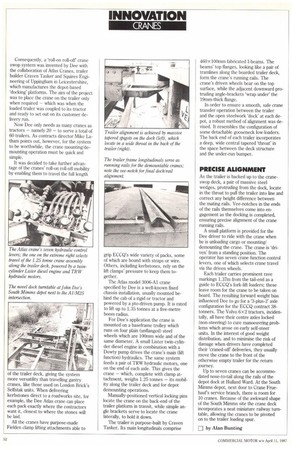INNOVATION
Page 54

If you've noticed an error in this article please click here to report it so we can fix it.
CRANES
Consequently, a 'roll-on roll-off' crane swop system was invented by Dee with the collaboration of Atlas Cranes, trailer builder Craven Tasker and Squires Engineering of Uppingham in Leicestershire, which manufactures the depot-based 'docking platforms. The aim of the project was to place the crane on the trailer only when required — which was when the Loaded trailer was coupled to its tractor and ready to set out on its customer delivery run.
Now Dee only needs as many cranes as tractors — namely 20 — to serve a total of 60 trailers. As contracts director Mike Latham points out, however, for the system to be worthwhile, the crane mounting/demounting operation must be quick and simple.
It was decided to take further advantage of the cranes' roll-on roll-off mobility by enabling them to travel the full length The Atlas crane's seven hydraulic control levers; the one on the extreme right selects travel of the 1.25 tonne crane assembly along the trailer deck, powered by a twincylinder Lister diesel engine and TRW hydraulic motors.
of the trailer deck, giving the system more versatility than travelling gantry cranes, like those used on London Brick's Selfstak units. When delivering kerbstones direct to a roadworks site, for example, the Dee Atlas crane can place each pack exactly where the contractors want it, closest to where the stones will be laid.
All the cranes have purpose-made Fielden clamp lifting attachments able to grip ECCQ's wide variety of packs, some of which are bound with straps or wire. Others, including kerbstones, rely on the lift clamps' pressure to keep them together.
The Atlas model 3006-Al crane specified by Dee is a well-known fixed chassis installation, usually mounted behind the cab of a rigid or tractor and powered by a pto-driven pump. It is rated to lift up to 1.35 tonnes at a five-metre boom radius.
For Dee's application the crane is mounted on a baseframe trolley which runs on four plain (unflanged) steel wheels which are 100mm wide and of the same diameter. A small Lister twin-cylinder diesel engine in combination with a Dowty pump drives the crane's main (lift function) hydraulics. The same system feeds a pair of TRW hydraulic motors, one on the end of each axle. This Oyes the crane — which, complete with clamp attachment, weighs 1.25 tonnes — its mobility along the trailer deck and for depot demounting operations.
Manually-positioned vertical locking pins locate the crane on the back-end of the trailer platform in transit, while simple angle brackets serve to locate the crane laterally, to hold it down.
The trailer is purpose-built by Craven Tasker. Its main longitudinals comprise 460 x 100mm fabricated I-beams. The beams' top flanges, looking like a pair of tramlines along the boarded trailer deck, form the crane's running rails. The crane's driven wheels bear on the top surface, while the adjacent downward protruding angle-brackets 'wrap under' the 19mm-thick flange.
In order to ensure a smooth, safe crane transfer operation between the trailer and the open steelwork 'dock' at each depot, a robust method of alignment was devised. It resembles the configuration of some detachable gooseneck low-loaders. The back end of each trailer incorporates a deep, wide central tapered 'throat' in the space between the deck structure and the under-run bumper.
As the trailer is backed up to the craneswop deck, a pair of massive steel wedges, protruding from the dock, locate in the throat to pull the trailer into line and correct any height difference between the mating rails. Vee-notches in the ends of the rails themselves come into engagement as the docking is completed, ensuring precise alignment of the crane running rails.
A small platform is provided for the Dee driver to ride with the crane when he is unloading cargo or mounting/ demounting the crane. The crane is 'driven' from a standing position. The operator has seven crane function control levers, one of which selects crane travel via the driven wheels.
Each trailer carries prominent rave markings 1,37m from the tail-end as a guide to ECCQ's fork-lift loaders; these leave room for the crane to be taken on board. The resulting forward weight bias influenced Dee to go for a '3-plus-2' axle configuration for the ECCQ contract 38tonners. The Volvo 6x 2 tractors, incidentally, all have their centre axles locked (non-steering) to cure manoeuvring problems which arose on early self-steer units. In the interest of good weight distribution, and to minimise the risk of damage when drivers have completed their 'craned-off deliveries, they usually move the crane to the front of the otherwise empty trailer for the return journey.
Up to seven cranes can be accommodated nose-to-tail along the rails of the depot dock at Hulland Ward. At the South Minims depot, next door to Crane Fruehauf's service branch, there is room for 10 cranes. Because of the awkward shape of the South Minuns site the crane deck incorporates a neat miniature railway turntable, allowing the cranes to be pivoted on to the trailer loading spur.




























































































